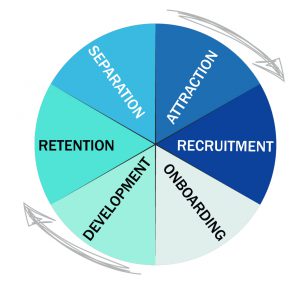The proven model known as the employee lifecycle (ELC), is a fantastic way to visualise your employee’s and how they engage with you. In this article, we share over 30 links, 4 experts thoughts and plenty of great tips.
So what are the six stages of employee engagement, and how do they all fit together?
I’ll explain this, as well as share interesting links and helpful tools to ensure you maximise your chance of success in building great teams and retaining those within them.
The six stages of the employee lifecycle
According to the very well-known Employee Lifecycle (ELC) model, there are six stages of engagement an organisation has with an employee.
These six stages can be illustrated as an ongoing, perpetual lifecycle, as shown below in this diagram.

Employee Lifecycle Model
Let’s go into a little more detail about each of these stages, and describe what they mean. We have included links to further reading within each stage, as well as helpful ideas on how to maximise your returns.
The six employee lifecycle stages are;

You can scroll down to read more, or click on these stage titles, to jump to that section.

Employee Attraction Stage
Attraction
The first stage of the employee lifecycle is the employee attraction stage.
No matter how great your product or service is, companies who don’t attract and retain great people will fail over time, every time. This is why attracting the right talent is crucial to any company’s growth strategy.
The attraction stage happens before you even have an open position. It’s often referred to, as the “employer brand”, a term coined in the early 1990’s.
The employer brand is “the image of your organisation as a ‘great place to work’ in the mind of current employees and key stakeholders in the external market (active and passive candidates, clients, customers and other key stakeholders).
The art and science of employer branding is therefore concerned with the attraction, engagement and retention initiatives targeted at enhancing your company’s employer brand.”
Brett Minchington, MBA, Author of Employer Brand Leadership – A Global Perspective.
Tips to succeed in the employee attraction stage
My three favourite tips when it comes to building a great employer brand and attracting great candidates, are something I have always done myself. These are;
Be well known in your industry
Encourage your managers to attend seminars and conferences, look for speaking opportunities and be a regular contributor to industry magazines or websites. The purpose here is to build your profile within your industry, as a great place to work.
Be known to have a great culture
Your best promoters are your own employees. By having a fantastic company culture, you increase the chances that your existing team will be out telling people how great it is to work with your team.
Another way to do this is share insights into your culture, using your own social media accounts. For example, Australian digital agency, Bam Creative, identified that many candidates follow their Instagram account. So they spend time posting images and comments from what it is like to be part of their team.
Offer attractive compensation and benefits
It goes without saying that you need to be at least competitive with compensation; not necessarily pay the most, but don’t pay the least either. Look for opportunities to offer softer benefits as well, such as team lunches, a day off on your birthday, and more.
In this article, Greg Savage, a respected voice across the global recruitment industry and regular keynote speaker, states “Throw out your 1990’s candidate playbook. Invest in social and digital and technology. Train recruiters on skills hunting, not job-board application screening.”
Referred employees have a 45 percent retention rate after two years.
– TLNT Research 2015
Further reading on employee attraction
Here are some great articles on employee attraction, to help you explore this phase further.
How to use Social Media to Attract Talent
Wikipedia: Employer Branding (Wikipedia)
8 Ways Companies Can Attract the Best Job Candidates (USnews)
Employee Onboarding Guide: Everything to Know
^ Return to top

Employee Recruitment Stage
Recruitment
The second stage of the employee lifecycle is the employee recruitment stage.
The recruitment stage is just that; the active phase of finding great talent to join your organisation. This could be the result of an existing role becoming vacant (see the Employee Separation stage below) or a new position being created.
CEO and co-founder Daniel Chait of Greenhouse shares his best recruiting tip;
“Recruiting is more competitive than ever! A winning plan offers a great candidate experience, supports collaborative hiring around a clear scorecard and process, and captures meaningful data allowing you to improve your hiring results over time.”

Image: Flickr
Four tips to succeed in the recruitment stage
Here are four great tips on how to succeed in recruiting the right talent for your team.
Ask for referrals from your team
Your greatest recruitment filter is often your own existing employees. As members of your industry, it is likely that they may have people they know who could be a perfect fit. Be careful though, to avoid hiring close friends of family of existing employees, as this can make the team dynamic very difficult.
Try different recruitment platforms
Don’t stick to the major recruitment websites or media. Think outside the box; where is it that many of your ideal candidates may be? Is it an industry meet up that you could attend, or is it that they all read this industry magazine you may wish to advertise in?
Be specific in who you are looking for
The worst employment advertisements are the ones that are very vague. Sure, it may be your plan to cast a wider net, however you should be careful to list all your pre-requisites to save both you and the candidates time in applying and assessing.
Involve your existing employees
As well as asking if your current employees know a good candidate, you could also request they help determine the best requirements for the role, and also assist you in reviewing the resumes and qualifications of any potential candidates.
You can also request that someone in a very similar role joins you in the interview process, to assess the candidates fit within the team.
We asked Adam Seabrook, Co-founder of Betterteam the following question; If there was one killer way to attract the best talent, what would you recommend?’
“Writing a job ad. It is such an important topic that we published a 9 chapter guide on job ads at Ultimate Job Advertisement Guide.”
Thank you, Adam, that’s a great resource!
Further reading on employee recruitment
Here are some great articles on employee recruitment, to help you explore this phase further.
How to Hire Employees for Cultural Fit
Your current candidate strategy is a catastrophe (Greg Savage)
15 Social Recruiting Tips Proven to Attract the Best Talent (Betterteam)
9 Simple Steps to Writing a Compelling Job Advertisement (Recruitloop)
^ Return to top

Employee Onboarding Stage
Onboarding
The third stage of the employee lifecycle is the employee onboarding stage.
This is the very critical stage of getting new hires adjusted to the performance aspects of their new job within your company quickly and smoothly. It is the process through which new hires learn the attitudes, knowledge, skills, and behaviours required to function effectively within an organisation.
Research has proven that the degree that managers make new hires feel welcomed into the team and prepared for their new roles, the faster that they will be able to successfully contribute to the organisation’s mission.
Tips to succeed in the Onboarding stage
Here are four great methods to ensure that a new employee onboarding goes smoothly for all concerned.
Have a job description
A job description doesn’t need to be long and academic. I prefer a one single page approach, where we list the most important duties, as well as experience and skills.
Discuss your company values and vision
In the first few days, it is vital that you sit down with the new employee, and take them through your company values and vision and what they all mean. Ask your recruit what the values mean to them, and if they have any questions.
Outline your expectations clearly
Although your role description will carry some of the detail, it is important to lead each employee through the expectations you for them, along with why they are important to the company success.
Follow up regularly
Don’t just complete your first weeks induction and leave it! Schedule a face to face with the new employee after a few weeks, and find out what is going on with them, what challenges they have found integrating with your team, etc.
Further reading on employee onboarding
Here are some great articles on employee induction, to help you explore this phase further.
10 Ways to Improve your Employee Induction Process
Developing an induction program: First impressions really do count (Smart Company)
Training Your New Staff For Success In Their First 90 Days (HR Onboard)
^ Return to top

Employee Development Stage
Development
The fourth stage of the employee lifecycle is the employee development stage. By consistently encouraging professional development amongst your team, you are helping skill your team members up, and help provide them with a future career path.
Tips on improving professional development in your team
We’ve chosen our four top tips for employee development.
Encourage external learning
Many organisations have found great value in providing their employees with opportunities to attend relevant conferences and seminars. This could take the form of sending them at the company cost, or indeed offer all employees a budget for their own initiated event attendance.
Assess their skills and knowledge together
All managers should work with their employees to identify their key skills and areas of expertise, and utilise these to plan and prioritise which areas require further development. Having a trusted manager act as a mentor can go a long way to encouraging openness.
Encourage your employees to be responsible for their own development
You should encourage and support every employee to develop a professional development action plan, that will help them develop their abilities, and increase chances of career advancement. Offer to help them do this together, or provide a template for all of your team to complete their own simple plan.
Reward employees who learn in their own time
Many people are regularly doing informal development outside of normal work hours. When you hear of someone with your team doing this, make a point to find out more about this, and sincerely thank them for their efforts. A little positive praise can go a long way to motivating people.
40% of employees who receive poor job training leave their positions within the first year.
– go2HR 2015 Survey
Gail Yeowell Managing Director Smart HR Solutions says;
Managers should set an example, be a role model, provide leadership and inspiration and ensure their people:
- Know and understand what is expected of them
- Have the skills and ability to deliver on these expectations
- Are supported by the Company to develop the capacity to meet these expectations
- Are given constructive feedback on their performance
- Have the opportunity to discuss and contribute to individual and team aims and objectives
- Continuously develop for existing and future roles
Further reading on employee development
Here are some great articles on employee development, to help you explore this phase further.
Why You Need to Encourage Professional Development for Your Employees (SHRM)
Our Tips Revealed: Employee Development Program Best Practices (Chronus)
Great Ideas for (Cheap!) Professional Development (the muse)
How To Get Employees To Care About Their Professional Development (Fast Company)
^ Return to top

Employee Retention Stage
Retention
The fifth stage of the employee lifecycle is the employee retention stage. This is where you focus your energies on keeping your top employees, and ensure that they are both happy and challenged in their role within the team.
Your positive company culture has a lot of influence in this area. A bad company culture will inevitably mean that your organisation will suffer from a high employee turnover, and that you will face the costs of having to replace your employees regularly.
Five tips to improve employee retention
Good news is, that with some commonsense and effort, employee retention doesn’t need to be hard to achieve. For example, some tips on ensuring you retain your key people, include;
Hiring the right people to begin with
See the attract and retain section of this article; if you are careful with who you hire to begin with, you stand a better chance of keeping employees in your team.
Build and foster great relationships with your team
This isn’t to mean you should invite them to your home for dinner, more that you should foster an open, honest and respectful relationship with everyone within your team.
Openly communicate your team mission and aspirations
One important element in employee retention is to ensure that they understand and are committed to the same mission and direction as the company. Ensure that you regularly communicate where they belong within the company, and how their role helps you execute your mission.
Seek their feedback and measure morale frequently
If your team is small enough, schedule a weekly face to face meeting, to discuss how they are going, and what problems or issues they are facing.
This is where tools such as employee pulse surveys are important. If you want to measure the overall team morale, and seek constant effective feedback, a tool such as our six question employee surveys makes great sense.
Understand what motivates various team members
There are many different types of personalities out there, and many different elements are important to people. Understanding what drives and motivates your employees means that you can communicate and reward them in different ways, to suit their own personality.

Photo: Nichole Burrows, Flickr
Further reading on employee retention
Here are some great articles on employee retention, to help you explore this phase further.
10 Ways to Improve Team Morale in under 10 Minutes
27 Fantastic Cheap or Free Employee Retention Strategies
Benefits of Cultural Diversity in the Workplace
3 Strategies to Increase Employee Retention (Hubspot)
How to Keep Your Top Talent (Harvard Business Review)
^ Return to top

Employee Separation Stage
Separation
The sixth and final stage of the employee lifecycle is the employee separation stage.
For most employees, there comes a point where the life cycle does come to an end. Employees may leave due to retirement, new employment, or for family or personal reasons. It’s important that your separation process is just as strategic as your onboarding process.
When a team member leaves, this can in turn affect other members of the team and it’s the manager or HR professionals job to make sure the employee who is exiting, leaves in a way that doesn’t disrupt the entire company.
Tips to succeed in the Separation stage
Here are four great ideas you could adopt, if you are faced with a key employee leaving your organisation unexpectedly.
Dig deep into the reasons behind the resignation
What they first state and what the actual reasons behind a resignation can often be different.
Remember the saying, ‘One door closes and another opens’
Just because you feel a sense of loss at this top performer leaving your team, it doesn’t mean that you may not find an even better employee to replace them.
Ask for honest feedback
A person leaving gives you a fantastic opportunity to glean some honest feedback on what it is like to be an employee at your organisation.
Remind the team that life goes on
Team morale can often be negatively affected by someone leaving your employ. It is worth concentrating on reaffirming your commitment to the team, and that whilst it is disappointing this person is leaving, the team will recover and grow as a result.
Further reading on employee separation
Here are some great articles on employee separation, to help you explore this phase further.
5 Top Reasons why Employees Leave their Jobs
What to Do When an Employee Resigns
5 Reasons (& Solutions) Why Your Best Employee Quits
Your Employee Resigns – What You Say and Do Next Is Important (Firebrand Talent)
Total replacement costs associated with employee turnover can be as high as 150%–200% of an employee’s annual salary.
– Deloitte, 2015
^ Return to top
In Summary
As we have discovered, the employee lifecycle model is an interesting method to visualize and plan for each stage of an employees interactions with your company. By focussing on doing the best you can in each stage, it is possible to attract and retain a fantastic team.
In summary, the six stages of an employee lifecycle are;
Attraction
Focus on building the right image, to attract the best candidates to your business.
Recruitment
Have a solid recruitment strategy to determine who would be best for your role.
Onboarding
Getting new hires up to speed efficiently is very critical to their success.
Development
Encouraging ongoing professional development within your team creates happier, smarter employees.
Retention
Spend time on ensuring you retain your top talent. A positive company culture is an absolute must.
Separation
Accept that people do leave. Have a great process in place to learn from the experience, and continue a good morale within your team.
All the best in building a great, motivated and productive team!



